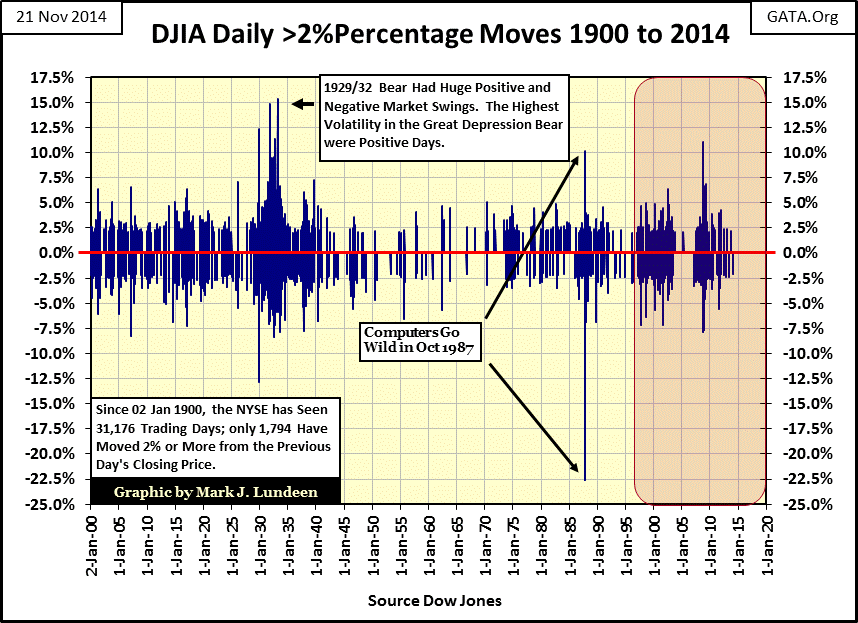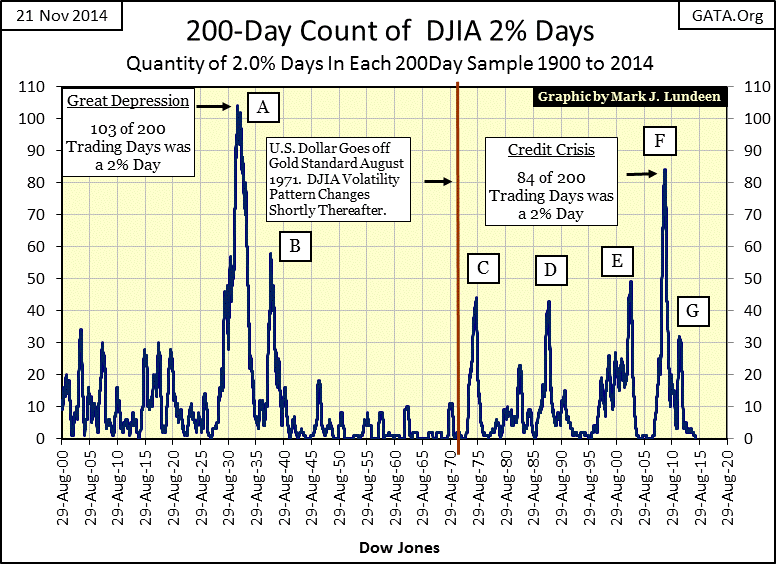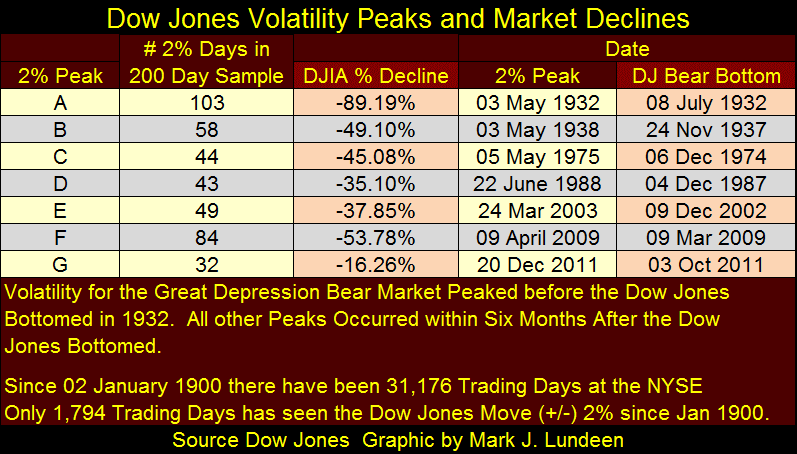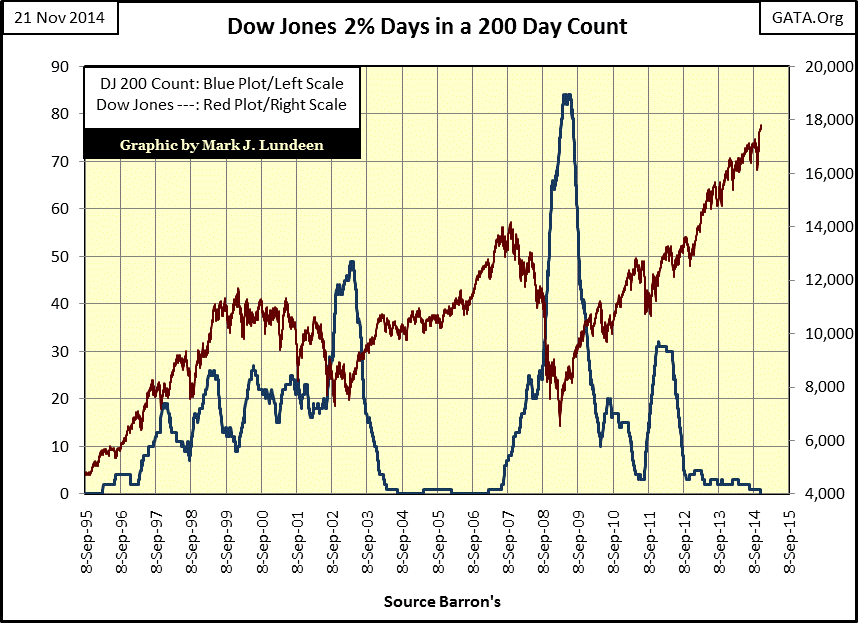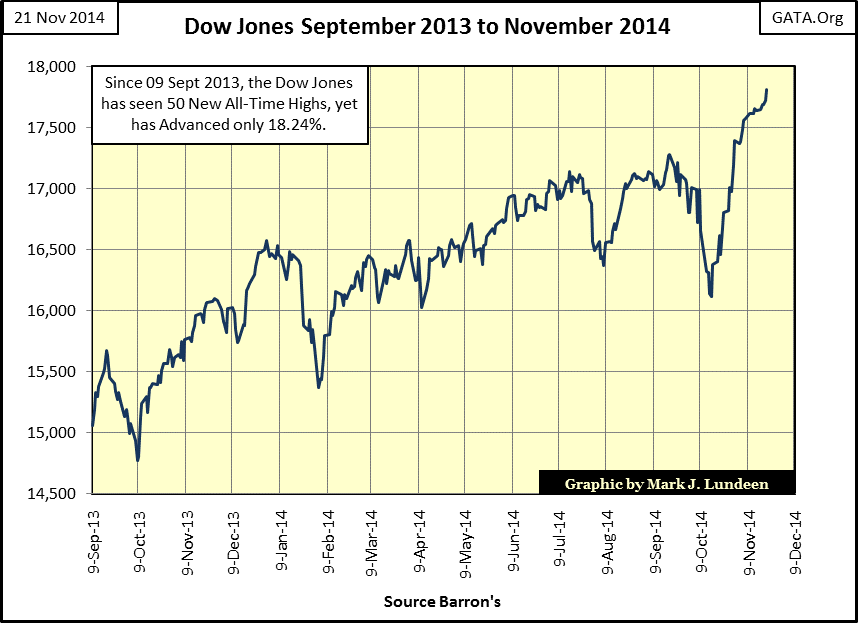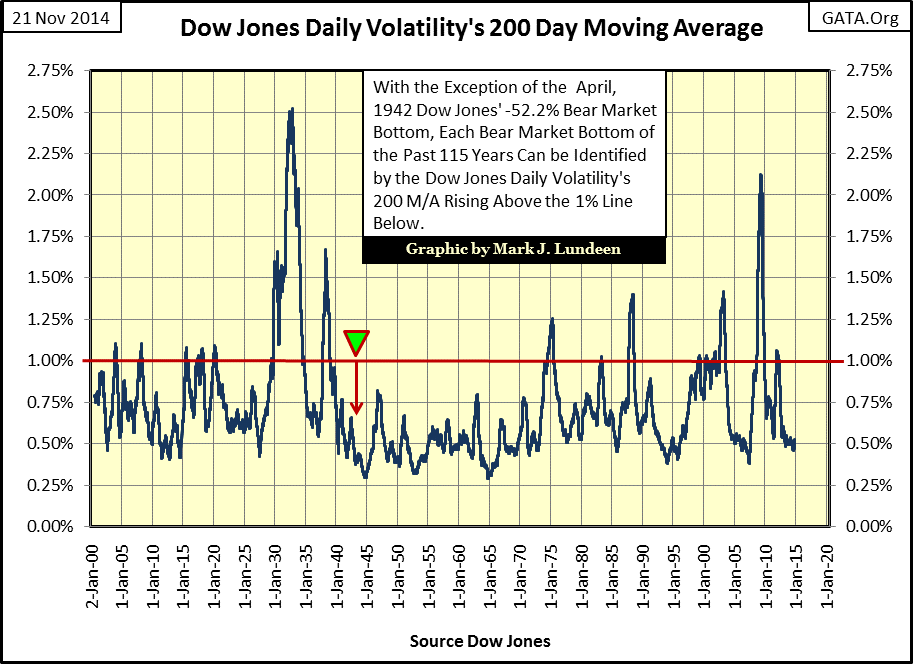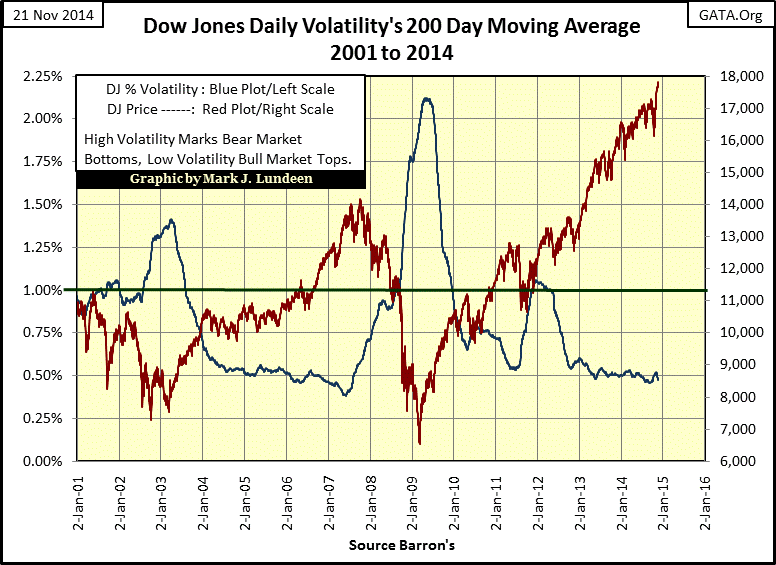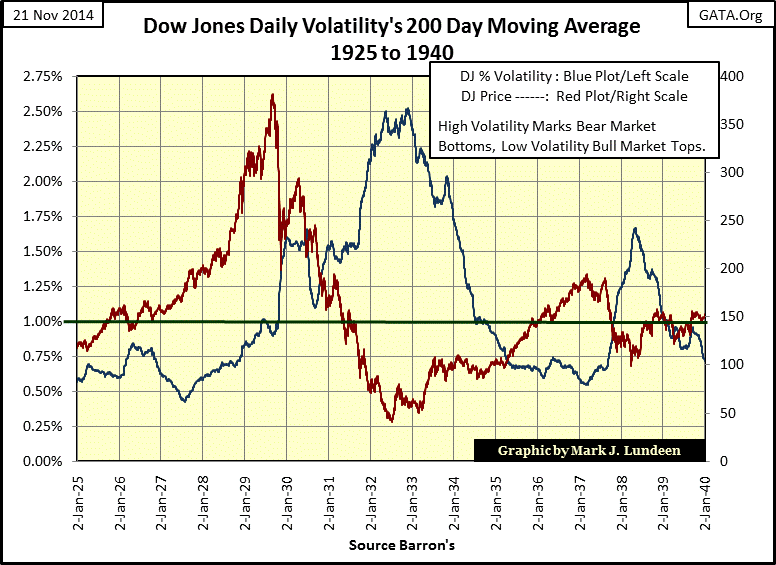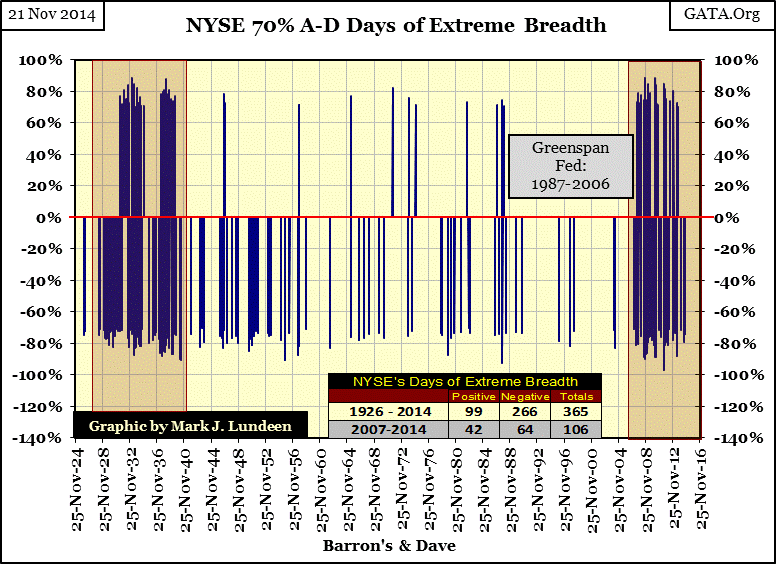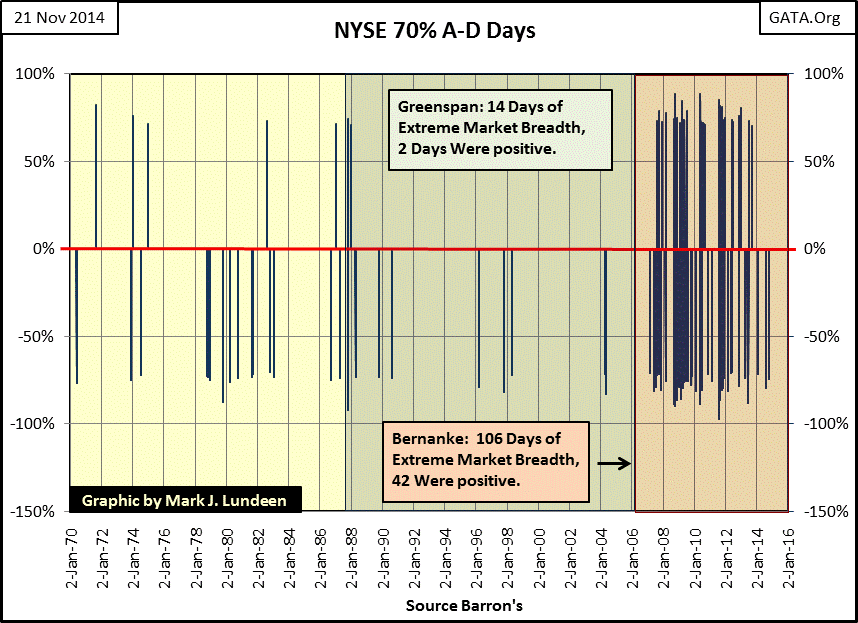Days Of Extreme Volatility And Market Breadth
Publishing Note: I’m taking a break for the holidays, but I’ll be back after the New Year comes in. However, if I see something exciting to write about, I may send something your way before 2015. Until then, I wish you a Happy Thanksgivings for next week, and a Happy Hanukkah or Merry Christmas a month from now. It’s a good time of year to remember of all the blessings God has sent our way, and be thankful for them.
2014 has been a very good year for the “policy makers.” Seeing the Dow Jones up 8.32% on the year tells us that, but more importantly we can see their success in enforcing “stability” in the economy by the lack of days of extreme volatility and breadth in the stock market. Let’s look at days of extreme volatility first; these are defined as days when the Dow Jones’ daily closing price is up or down 2% or more from the previous day’s close. Such days are rare market events, except when Mr Bear is prowling Wall Street feasting on overpriced financial garbage, of which there is plenty lying about as we approach the end of 2014.
Here’s a chart showing every Dow Jones 2% day since January 1900. Over the past 114 years there have been 31,176 trading days at the NYSE, yet only 1,794 have seen a Dow Jones move of 2% or more from the previous day’s close. Although days of extreme volatility are rare market events they frequently occur during bear markets, making the clusters of 2% days seen below RED FLAGS of serious market declines. Note also that all big double-digit positive daily advances since January 1900 have been exclusively bear market events. Why might that be? Simple; when Mr Bear is hard at work he makes life miserable for both longs and shorts alike. Can you imagine the horror of holding a profitable short position one day and then seeing the Dow Jones gain over 10% the next? And those gains were among quality blue-chip stocks; the garbage stocks the shorts had been ganging up on were up even more on the day.
There were only a hand full of these hyper-extreme up days during the Great-Depression. We didn’t see another until half a century later in October 1987 when Wall Street’s computers went on a selling spree, giving Alan Greenspan his first opportunity to show the world what a genius like himself could do for market valuations by “injecting liquidity” into the financial markets. The next positive 10% daily move in the Dow Jones didn’t occur until the mortgage crisis more than thirty years later.
Next we look at the Dow Jones’ 200 Day Count; or the number of Dow Jones 2% days (days of extreme volatility) in a running 200 day sample from January 1900 to today. The two deepest bear market bottoms are easily identifiable in the chart: the Great Depression bear market bottom of 1932 (89% decline) with 102 days of extreme volatility in a 200 day sample, and the Credit Crisis bear market (54% decline) with 83 days of extreme volatility in a 200 day sample. You might think that the #3 Dow Jones bear market is identified with the 1938 peak, but that is actually the #4 Dow Jones bear market bottom (49% decline). The third deepest Dow Jones bear market occurred in April 1942 (52% decline) with only 6 days of extreme volatility in its 200 day count.
What’s with that? After the two massive bear market bottoms in the 1930’s (1932 & 1938) the public was out of the stock market, not to return until the 1980s. Then, in 1942 World War Two became the focus of public attention. By April of 1942, seeing the Dow Jones crash by 50% seemed like nothing unusual among the market professionals who had survived the 1930s, who saw this decline as no reason to panic.
Here is a table listing the seven 200 Count Peaks shown above with their associated Dow Jones declines.
The chart above also displays the stock market during its different eras of the past 115 years:
- There was the unregulated stock market from 1900 to 1921, the era before the full influence of the Federal Reserve impacted the market.
- During the 1920s we see the lowest volatility since 1900, which occurred during the Roaring 1920s Bull Market, followed by the depressing 1930s with its insanely high daily volatility.
- From the April 1942 bear market bottom until shortly after Washington severed the dollar from the Bretton Woods’ $35 an ounce gold peg in August 1971, the stock market saw its period of lowest volatility of the 20th century. During these three decades the Dow Jones increased from 92.92 in April 1942 to 897.01 in August 1971, a nice thirty one year gain of 824%.
- Decoupling the dollar from its $35 an ounce peg in 1971 increased the supply of money circulating in the stock market, which also increased the frequency of inflationary bull and deflationary bear markets. Since 1973 we’ve rarely seen fewer than five days of extreme Dow Jones volatility in the Dow Jones’ 200 day count, and all too frequently many more. If central bankers today are concerned about market “stability”, it’s because they know that their own “monetary policies” are causing its instability.
One last comment on the Dow Jones days of extreme volatility: as of this Monday the Dow Jones’ 200 count has been free of 2% days for the first time since February 2007. As we see below, this is unusual for the Dow Jones’ 200 count and if the past is any guide, (as it usually is), then seeing the Dow Jones’ 200 day count at zero portends future market instability.
Here’s the Frequency Distribution for the Dow Jones BEV values from Sept 2013 to present. The table’s first row (0%) shows that over the past fourteen months the Dow Jones has made 50 new all-time highs! So for well over a year, 16.34% of all Dow Jones daily closes have reached a new all-time high! This is quite a market anomaly, one that is not likely to be repeated over the next fourteen months. The next row (-0.000001%) includes all the Dow Jones closings just short of making a new all-time high to 4.999% from reaching one. Here we see 242 daily closings within 5% of a new all-time high. The third row (-5%) shows how many days have closed from within -5.0% to -9.999% of a new all-time high: (14). This is remarkable; only 4.58% of the last 306 trading days has the Dow Jones closed between 5% and 9.999% from its last all-time high.
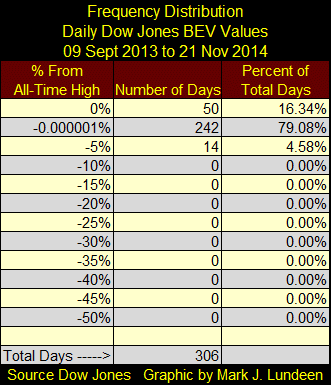
The fourth row (-10%) shows that on no day since 09 Sept 2013 has the Dow Jones closed 10%, or more below its last all-time high. Like I said, the last year has been a good one for the “policy makers”; 95.42% of all daily closings for the past fourteen months have been within 5% of their last all-time high. So it’s not at all surprising to see the Dow Jones’ 200 count at zero, free of any Dow Jones 2% days for the first time since 2007.
Here’s the chart plotting the Dow Jones price data used in table above. Since 09 Sept 2013 the Dow Jones has gained 18.24%, but with 50 new all-time highs and no significant double digit correction (see Frequency Table above) I would expect to see the Dow Jones a little higher. Heck, ten of the sixteen daily closings since October 31st have been new all-time highs, taking the Dow Jones up 419 points, a gain of only 2.41%. With the major buying interest coming from the Federal Reserve and corporate buyback programs, neither group is using their own personal money for these purchases, it’s foolish to attempt to predict a top. But it sure seems like the bulls are running out of steam.
This next chart plots the 200 day moving average for the Dow Jones’s daily volatility. As a rule of thumb; money is made by the stock market bulls on declining daily volatility, and money is lost as volatility increases. Seeing the Dow Jones daily volatility (200 day moving average) now at its 0.50% line strongly suggests that the best days for the stock market bulls are now behind them. It seems prudent to stop looking for reasons to buy, and begin looking for reasons to sell one’s favorite stocks and lock in current gains. Be prepared to stay out of the market for a few years, and not return until daily volatility is once again well above the 1.0% line.
Below is the volatility data above (Blue Plot/Left Scale) from 2001 to 2014 plotted with the dollar value of the Dow Jones (Red Plot/Right Scale). The relationship between daily volatility, as measured by the Dow Jones Daily Volatility’s 200 Day Moving Average and advances and declines in the stock market is self-evident.
Below is the data spanning from 1925 to 1940. Although daily volatility began increasing in 1927 during the Roaring 20’s bull market, it was small compared to the volatility the market endured from late 1929 to 1932. And as was the case above in 2003 & 2009, when daily volatility began to decline in 1933, the market began to advance. This same pattern of volatility and valuation was repeated again in late 1930s, as has been the case during the entire 20th & 21st centuries.
Currently the market is rising on low volatility, but how long this will continue is a question I can’t answer. But if 114 years of market history holds true, when the final top in the current advance is in, it will occur in on rising daily volatility.
Now on to days of extreme market breadth, or NYSE 70% A-D days, computed by the following formula
Daily NYSE Advances – Daily NYSE Declines / Total NYSE Shares Traded
When the above formula results in a value of (+/-) 70% or more, I define this as a day of extreme market breadth. These are very rare market events. The chart below covers 23,508 NYSE market sessions since 1924, of which only 365 were days of extreme breadth. The chart includes a table for their breakdown over the years. The current cluster of NYSE 70% A-D days began in February 2007, about the time the first cracks in the sub-prime mortgage bubble began to show. With the most recent day of extreme market breadth occurring on 09 October 2014 (-74.20%), and two others in 2014, it appears that the most intense cluster of extreme market breadth since the Great Depression is still growing, which isn’t a sign of internal market “stability.”
The most worrisome thing about extreme market breadth is its clusters of positive days, sure signs of ongoing bearish activity in the stock market. Note the gap of positive NYSE 70% days during the Great Depression between December 1934 and June 1937. Even though negative NYSE 70% days continued to occur, the Dow Jones advanced 71.4% during this three and a half year period. And once positive days of extreme market breadth returned again in June 1937, it marked the beginning of the second bear market of the 1930s.
It’s worthy of note in the chart below we see only two positive NYSE 70% A-D days during the Greenspan Fed years, and those were during the 1987 crash. It’s remarkable that Greenspan saw only fourteen days of extreme market breadth during his nineteen year tenure at the Federal Reserve, and predictably, this famine in days of extreme market breadth occurred during a historic bull market bubble.
His successor, Doctor Bernanke (as we all know), had some problems with “market stability”, so it’s not surprising that there were 106 days of extreme market breadth during his tenure, with 42 of them positive. In fairness to Doctor Bernanke I must note that Janet Yellen has been Fed Chairman since 03 February 2014, so the two most recent negative NYSE 70% A-D days occurred on her watch.
Investors should be aware that due to central bank interference the financial markets are currently very unstable, as evidenced by the stock market’s days of extreme volatility and breadth. The current good times may continue to roll on for a while, but then again maybe not. It’s important to understand that Mr Bear won’t be going away until he finally get his opportunity to remove the garbage from everyone’s balance sheet, from Joe Six-Pack to the Federal Reserve’s. I expect the pending bear market will prove to be horrendous, possibly worse than the Great Depression bear market.
When the big-furry guy finally goes back to work, I truly believe that the asset to hold is one with no counter-party risk: gold and silver bullion. I expect the precious metal mining and exploration shares will also enter a historic bull market, just as they did during the Great Depression.






